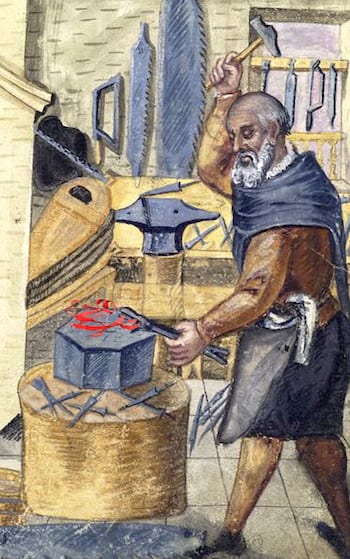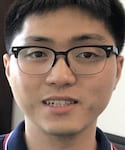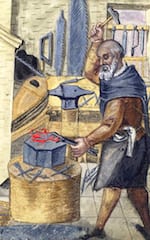NEWS RELEASE
Editor’s note: Links to high-resolution images for download appear at the end of this release.
David Ruth
713-348-6327
david@rice.edu
Mike Williams
713-348-6728
mikewilliams@rice.edu
Rice advances the art of protein blacksmithing
Researchers forge new computational tools to make more accurate predictions of protein structures
HOUSTON – (April 15, 2019) – Where the village smithy once stood now stands an algorithm, its mighty mathematical hammer pounding proteins into shape.
The blacksmith’s profession is a worthy analogy for what Rice University scientists have wrought: A new method for making accurate structural models of proteins that takes far less computational power than existing brute-force approaches.

Rice University researchers were inspired by the ancient work of blacksmiths as they refined their computational models of how proteins fold. The models are intended to help structural biologists who design drugs and other therapies. Rice University/Wikipedia
The goal of the structural models produced by computation, according to physicist Peter Wolynes of Rice’s Center for Theoretical Biological Physics (CTBP), is to be as detailed and useful as those produced by laborious experimental means, particularly X-ray crystallography, that provide detailed locations for every atom within a protein.
The new method takes its inspiration from metallurgy. Like the blacksmith who must not only heat and cool a metal but also strike the metal just right to move it closer to a useful product, the Rice project led by Wolynes and alumnus Xingcheng Lin applies force at strategic points during the simulation of protein models so as to speed up the computation.
“One big question is whether we could ever become more confident in the accuracy of the results of a simulation than the result of X-ray experiments,” Wolynes said. “I’m on the verge of saying that’s where we are now but, of course, time will tell.”
The study appears this week in the Proceedings of the National Academy of Sciences.
Researchers have used X-ray crystallography for more than a century to learn the positions of atoms within molecules from their structures in protein crystals. This information is the starting point for structural biology studies, and accuracy is thought to be essential for designing drugs to interact with specific proteins.
But crystal structures provide only a snapshot of a protein that in reality changes its global shape and detailed atomic positions as the protein carries out its work in the cell.
Wolynes and his colleagues have long pioneered computational methods to predict folded structures from the energy landscape encoded in the protein’s amino acids. In the new work, they address the detailed placement of the side chains of the amino acids that can be pushed this way or that by an algorithm that starts from a moderate resolution view of the global structure.
“To reach the resolution we want starting from the initial coarse-grained models, we would normally need to run the computer for two months,” he said. “But we found we could first simulate the motions from the coarse-grained model to find those motions that would change the patterns of bonding in the molecule most substantially.
“Some motions don’t do anything at all: You may be flapping your hand, but the important motion is in bending your elbow,” Wolynes said. “So, we came up with a recipe to select the most significant motions and used these to bias another simulation done at high resolution. We deliberately used force to push the proteins just in those directions, then looked at the structures that resulted to see if they were more stable than what we started with.”
Like a blacksmith hammering sand out of a piece of metal, the Rice team also found methods to eliminate “grit” from their models: slow-moving, bulky side chains whose slow dynamics sucked up computer time as a protein folded. Taking the grit out didn’t change the result, but made computation much faster.
“Metallurgists heat things up and cool things down to anneal them, but they also figure out how to make the big motions that aren’t going to spontaneously happen if you just keep the metal at a high temperature,” Wolynes said. “We’ve been doing annealing with coarse-grained models for a long time. But blacksmiths also pound the metal to take out the sand, or slag, and that inspired us to mechanically deform proteins, too.”
Wolynes said the CTBP has methodically updated its models for protein folding and structure prediction using new computer languages over the years, which in turn has helped the researchers attack more sophisticated problems.
“Recoding the models has allowed us to look at molecules that are 10 times bigger than before,” he said. “There’s no new physics, just new programming and better parallel computers, but it’s making a real difference in the practical problems we can now tackle.”
Co-authors of the paper are Rice research scientist Nicholas Schafer, graduate students Wei Lu, Shikai Jin, Xun Chen and Mingchen Chen, and José Onuchic, the Harry C. and Olga K. Wiess Chair of Physics, a professor of physics and astronomy, of chemistry and of biochemistry and cell biology and co-director of the CTBP. Lin is now a postdoctoral fellow at the Massachusetts Institute of Technology. Wolynes is the D.R. Bullard-Welch Foundation Professor of Science and a professor of chemistry, of biochemistry and cell biology, of physics and astronomy and of materials science and nanoengineering, and co-director of the CTBP.
The National Science Foundation and the National Institute of General Medical Sciences supported the research.
-30-
Read the abstract at www.pnas.org/cgi/doi/10.1073/pnas.1900778116.
Follow Rice News and Media Relations via Twitter @RiceUNews.
Related materials:
Wolynes Research Lab: https://wolynes.rice.edu
Center for Theoretical Biological Physics: https://ctbp.rice.edu
George R. Brown School of Engineering: https://engineering.rice.edu
Images for download:
https://news2.rice.edu/files/2019/04/0415_BLACKSMITH-1-WEB-1n7cykw.jpg
Rice University researchers were inspired by the ancient work of blacksmiths as they refined their computational models of how proteins fold. The models are intended to help structural biologists who design drugs and other therapies. (Credit: Rice University/Wikipedia)
https://news2.rice.edu/files/2019/04/0415_BLACKSMITH-2-WEB-17tf7hl.jpg
CAPTION: Peter Wolynes. (Credit: Jeff Fitlow/Rice University)
https://news2.rice.edu/files/2019/04/0415_BLACKSMITH-3-WEB-1dnm0vc.jpg
CAPTION: Xingcheng Lin. (Credit: Rice University)
Located on a 300-acre forested campus in Houston, Rice University is consistently ranked among the nation’s top 20 universities by U.S. News & World Report. Rice has highly respected schools of Architecture, Business, Continuing Studies, Engineering, Humanities, Music, Natural Sciences and Social Sciences and is home to the Baker Institute for Public Policy. With 3,962 undergraduates and 3,027 graduate students, Rice’s undergraduate student-to-faculty ratio is just under 6-to-1. Its residential college system builds close-knit communities and lifelong friendships, just one reason why Rice is ranked No. 1 for lots of race/class interaction and No. 2 for quality of life by the Princeton Review. Rice is also rated as a best value among private universities by Kiplinger’s Personal Finance.






